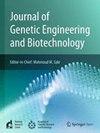Bioremediation of crude oil and heavy metal pollutants in marine environment by biosurfactant, rhamnolipid isolated from Stutzerimonas stutzeri − MW15
IF 2.8
Q3 Biochemistry, Genetics and Molecular Biology
Journal of Genetic Engineering and Biotechnology
Pub Date : 2025-05-29
DOI:10.1016/j.jgeb.2025.100507
引用次数: 0
Abstract
Objectives
The current research aimed to study the biodegradation potential of biosurfactants isolated from marine bacteria against crude oil and heavy metals.
Methods
Hemolytic activity, oil displacement, drop collapse, tilted glass slide, and emulsification index tests were employed for screening the biosurfactant production efficiency of marine bacteria which was cultured on an enrichment mineral medium. Based on the highest emulsification activity, the most effective bacterial isolates were selected and subjected to biosurfactant isolation. Further, the characterization using TLC, FTIR, and LC-MS were performed. The bacteria and genes that produced biosurfactants have been identified via 16S rRNA sequence analysis.
Results
The isolate MW 15 was selected for structural identification given its maximum oil displacement activity, effective surface tension reduction potential, and favourable emulsification index (E24) of 51.3 %. The purified biosurfactant from MW 15 exhibited structural similarities to rhamnolipid biosurfactant. The biosurfactant-produced strain was identified as Stutzerimonas stutzeri by 16Sr RNA sequencing and the nucleotide sequences were deposited in GenBank with accession number PP779775. Mega 11 software was employed for constructing the phylogenetic tree, and it was confirmed that a gene which produces rhamnolipid (rhlA) was present.
Conclusion
Totally eight bacteria were isolated from petroleum hydrocarbon-contaminated marine harbour water. The isolate Stutzerimonas stutzeri showed better production of biosurfactants and biodegradation ability when compared with other biosurfactant-produced isolates. The current investigation promises the use of marine bacteria to produce biosurfactants with biodegradability, less toxicity, and eco-friendly nature.

从Stutzerimonas stutzeri - MW15分离的鼠李糖脂生物表面活性剂对海洋环境中原油和重金属污染物的生物修复
目的研究海洋细菌分离的生物表面活性剂对原油和重金属的降解潜力。方法采用溶解活性、驱油、滴塌、倾斜玻片和乳化指数等试验,对富集矿物培养基上培养的海洋细菌的生物表面活性剂生产效率进行筛选。以最高的乳化活性为基础,选择最有效的菌株进行生物表面活性剂分离。此外,采用TLC、FTIR和LC-MS进行表征。通过16S rRNA序列分析鉴定了产生生物表面活性剂的细菌和基因。结果分离物mw15具有最大的驱油活性、有效的表面张力还原电位和良好的乳化指数(E24),为51.3%。从mw15中纯化的生物表面活性剂具有与鼠李糖脂生物表面活性剂相似的结构。通过16Sr RNA测序鉴定该菌株为Stutzerimonas stutzeri,并将其核苷酸序列存入GenBank,登录号为PP779775。利用Mega 11软件构建系统发育树,证实存在鼠李糖脂(rhlA)产生基因。结论从石油烃污染的海港水体中共分离出8种细菌。与其他产生物表面活性剂的菌株相比,该菌株具有更好的生物表面活性剂生产能力和生物降解能力。目前的研究有望利用海洋细菌生产生物表面活性剂,具有可生物降解性、低毒性和生态友好性。
本文章由计算机程序翻译,如有差异,请以英文原文为准。
求助全文
约1分钟内获得全文
求助全文
来源期刊

Journal of Genetic Engineering and Biotechnology
Biochemistry, Genetics and Molecular Biology-Biotechnology
CiteScore
5.70
自引率
5.70%
发文量
159
审稿时长
16 weeks
期刊介绍:
Journal of genetic engineering and biotechnology is devoted to rapid publication of full-length research papers that leads to significant contribution in advancing knowledge in genetic engineering and biotechnology and provide novel perspectives in this research area. JGEB includes all major themes related to genetic engineering and recombinant DNA. The area of interest of JGEB includes but not restricted to: •Plant genetics •Animal genetics •Bacterial enzymes •Agricultural Biotechnology, •Biochemistry, •Biophysics, •Bioinformatics, •Environmental Biotechnology, •Industrial Biotechnology, •Microbial biotechnology, •Medical Biotechnology, •Bioenergy, Biosafety, •Biosecurity, •Bioethics, •GMOS, •Genomic, •Proteomic JGEB accepts
 求助内容:
求助内容: 应助结果提醒方式:
应助结果提醒方式:


